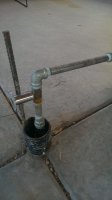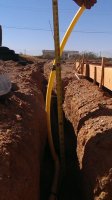figs
New Member
About three years ago, I had a contractor install 1-1/4" polyethylene gas line for my outdoor fireplace and two fire bowls. I was unable to complete the project at that time for many reasons, but I am starting back to work on it now. I have a few questions about the gas line:
Some of the stubs with key valves attached need to move a few inches For example, I need to move the key valve one cell over to the right in the attached image. What is the best way to do this without unscrewing/loosening the pipes from the risers in the ground?
Is it bad to have couplings and elbows in the block for reasons such as leaks, etc.? I will need to use couplings and elbows to move the key valves. Any other ideas?
When I run gas pipe from the key value to the inside of the fireplace hearth, do I use the green PVC coated gas pipe or flexible gas line?
Is it common to encase the gas line in block? What if one needs to access it later for service?
I would also like to pressure test the gas line before I surround it with block. Does 50 - 60 PSI for 15 minutes sound correct for pressure testing the polyethylene gas line? I can't remember what the contractor test it at for the inspection.
By the way, I live in Surprise, Arizona.
Some of the stubs with key valves attached need to move a few inches For example, I need to move the key valve one cell over to the right in the attached image. What is the best way to do this without unscrewing/loosening the pipes from the risers in the ground?
Is it bad to have couplings and elbows in the block for reasons such as leaks, etc.? I will need to use couplings and elbows to move the key valves. Any other ideas?
When I run gas pipe from the key value to the inside of the fireplace hearth, do I use the green PVC coated gas pipe or flexible gas line?
Is it common to encase the gas line in block? What if one needs to access it later for service?
I would also like to pressure test the gas line before I surround it with block. Does 50 - 60 PSI for 15 minutes sound correct for pressure testing the polyethylene gas line? I can't remember what the contractor test it at for the inspection.
By the way, I live in Surprise, Arizona.






